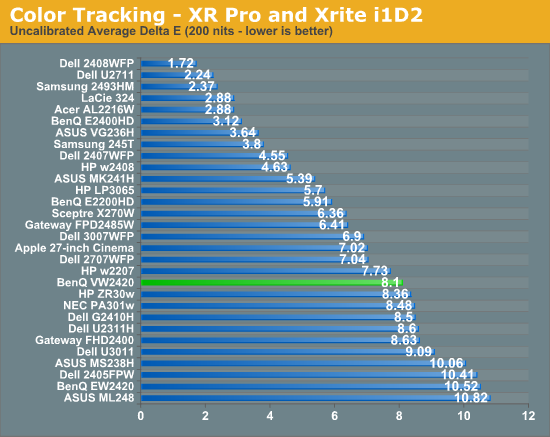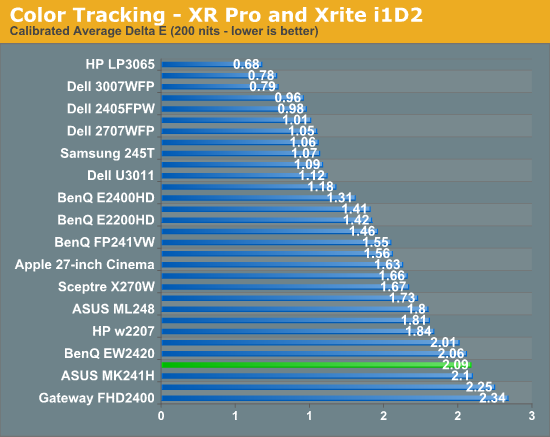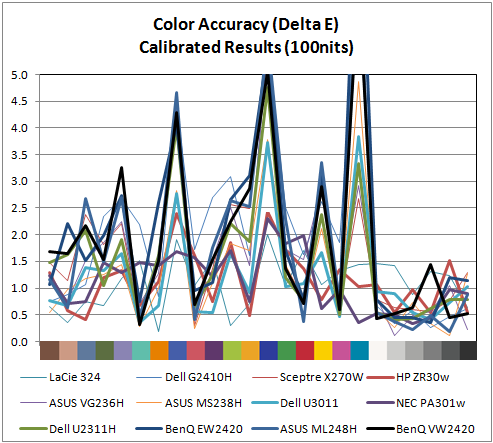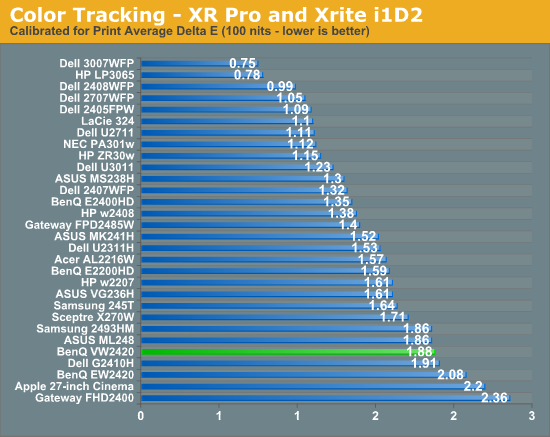BenQ VW2420H Monitor Review
by Chris Heinonen on December 10, 2011 2:45 AM ESTViewing Angles and Color Quality
The BenQ uses a *VA panel (specifically A-MVA) and because of that the viewing angles on it are overall very good. You can get a bit of contrast shifting when you move to the extremes, but for all practical purposes there should be no real contrast shifts while working on it. Since this is designed just for desktop work and not for multiple people to use while gaming or watching TV, the viewing angles are very good.
When initially hooked up and set to 200 nits of light output, the average dE of the BenQ is in the high single digits, which unfortunately is very good for a consumer class LCD monitor—only higher quality professional (or at least prosumer) displays tend to be factory calibrated for accurate colors. The worst color is pure white, with the rest of the grayscale getting better as it gets darker, but overall this isn’t a monitor you would want to use for serious color work straight out of the box.


Of course, the uncalibrated results won’t be that important to people that care about color quality, since they would be calibrating the monitor regardless of the performance out of the box. In this case the BenQ performs well, though it's strictly average for a consumer display. Our average dE comes down to just about 2, and the majority of the grayscale is at 1 or below. The main errors are in the blue swatches that cause most displays issues, or fall outside of the sRGB colorspace. Calibrated the BenQ falls strictly in the “good, not exceptional” category for dE performance.


If you are doing print work and using a light output of closer to 100 nits than 200 nits, the performance of the BenQ is slightly better, but still in the range of most displays. The grayscale is more accurate which I like to see, and the color errors are in the same positions as before. If the 200 nits calibration data was close enough to accurate for you, then the 100 nits calibration data will be good enough as well, but the numbers are very similar.












48 Comments
View All Comments
justaviking - Saturday, December 10, 2011 - link
I just bought a 16:10 TV/Monitor.Very cheap, but after recently buying a smaller yet similar product for my wife, which she loves, so I thought I'd give it a whirl mostly because of the aspect ratio, and the bonus of doubling as a TV, and an unbeatable price..
Hannspree ST289MUB 28" Class LCD HDTV - 1080p
1920x1200, 16:10
800:1 Native, 10000:1 Dynamic, 5ms, 60Hz, 2 HDMI, Black
It was (still is) $200 after the sales price and a $50 rebate at TigerDirect.
I wonder how a budget item like this would stand up to an AnandTech review. Is it a great deal or a waste of money?
JWatson - Sunday, December 11, 2011 - link
The Hannspree use TN panels. Meaning the black levels/contrast aren't nearly as good, as well the viewing angles. I used to have the older non-TV version of the Hannspree. It was a great monitor at 27.5 for just everyday computer purposes, but when it came to movies and gaming...well the blacks were not great, nor the viewing angles, or backlight bleed.To see what I mean by poor viewing angles try this link
http://www.lagom.nl/lcd-test/viewing_angle.php
Those letters should all be the same color. If you have a *VA or *IPS the text will have the same color. If you are using a TN panel, it'll show different color for the text depending on your angle.
If you need to do any professional photo editing on the Hannspree...forget about it. You can't calibrate to be accurate enough. You need a *VA or *IPS panel monitor.
If you just want a large, web browsing, office work, semi tv and movie watching, then the Hannspree is great for the price. I still recommend it as a budget monitor. However, If you're looking for quality...look elsewhere.
justaviking - Monday, December 12, 2011 - link
Thanks for the great link. It provides wonderful examples and offers a great tip of viewing at a distance equal to your diagonal size when evaluating the screen.I viewed the images on the $15 montior I have a work. At least I hope they only paid $15 for it. Ewww.
I can't wait to try it on a few of my monitors at home. I figured there would be compromises on the Hannspree. But for the price and features I'm hoping it'll be acceptable.
I don't have very demanding needs (no professional photography work, though I do enjoy video editing). But it'll be fun to compare a couple of the Samsung monitors I like with the Hannspree TV/monitor.
There's no need to test my wife's laptop. It is horrible. A nice i5 processor paired with a screen that has about a 10 degree viewing angle. Gahh!
Thanks again.
SirGCal - Saturday, December 10, 2011 - link
With most games locked to console specs and vertical fov, 16:9 actually has more viewable space. If they don't have locked vertical FOV (rare), then the 10's can show more due to their increased vertical pixel space... But still, since 16:9 is the 'industry' standard in everything accept desktop's, I fully expect the 10's to disappear. Besides, the higher res 16:9's are right around the corner anyhow with Ultra HD. 1200 and 1600 vertical pixels are most likely going away. 1080 will likely be the default standard with 1440 and 2160 being the higher end models. Maybe we'll even see some 4320s... I suspect we'll start to see these more often very soon (some already available...)Personally, I like the wider screen of the 16:9 anyhow, especially with vertically locked graphics engines in many of today's games.
JediJeb - Saturday, December 10, 2011 - link
Honestly I still prefer the 1280X1024 ratio, (4:3 I think it is) since most of my work deals more with vertical space than horizontal.kmmatney - Sunday, December 11, 2011 - link
1280 x 1024 is a 5:4 ratio. LCD monitors with a 4:3 ratio were rare (and now extinct) , but I'm typing on one now (1400 x 1050). It's great very general work, and I prefer it over 16:9, but not 16:10.kkwst2 - Monday, December 12, 2011 - link
I have a 19" 1280x1024 next to a 24" 1920x1200 at home, and used to like this setup a lot. But now at work I have a 30" 2560x1600 next to 1200x1900 (24" oriented vertically) and I like this much better.I use the vertical 24" for displaying Outlook, Word docs, and some more vertically oriented Excel workbooks. Also good for code. The 30" I use for graphics and layout stuff, as well as side-by-side spreadsheets. I used to think I would always want one screen that is more square, but now I really like the two screens with opposite orientation. The 30" is a luxury, but not necessary. When my 19" dies I'm going to two 24" at home with opposite orientation.
ibtar - Saturday, December 10, 2011 - link
I purchased an EW2420 (essentially the same panel) to compare to a ZR24w and just didn't care for it. The only thing it had going for it was it's contrast and black level. Colors just never looked quite right and A-MVA viewing angles simply do not come close to IPS. Despite the contrast ratio being nearly 5 times as high, I simply couldn't keep it.jabber - Saturday, December 10, 2011 - link
And whilst I assume its just a budget E-IPS panel its a very nice monitor to work with.Reasonable adjustment, good viewing angles, calibration report in the box and a matte effect bezel!
All for just £125! For a day to day work monitor its a bargain.
jabber - Saturday, December 10, 2011 - link
In fact just plugged my Spyder3Pro calibrator and ran the full calibration on the USER and sRGB modes.Other than a adjustment on the brightness the difference in calibration was minimal so pretty accurate out of the box.